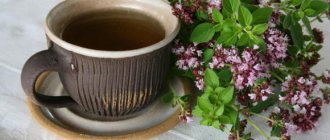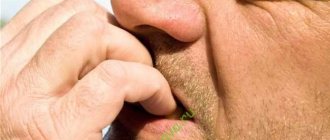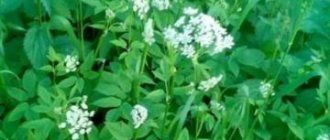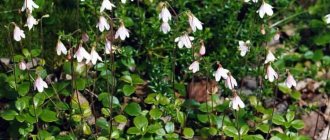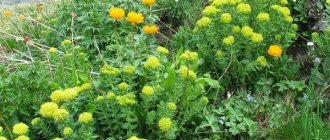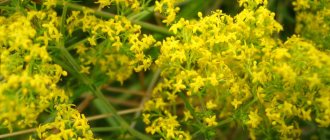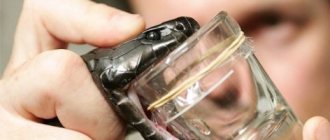Plant characteristics
The common watercress belongs to the cruciferous family and prefers an aquatic or semi-aquatic “lifestyle”. The plant is collected along the banks of rivers, ponds, swamps and even in large puddles.
The herb is valued for its medicinal qualities. But, unfortunately, it is not so easy to collect and prepare, since the young shoots and leaves have the greatest value. Dried herbs lose most of their unique properties and are suitable for food as a seasoning.
You can grow watercress in ordinary soil, without flooding the beds with water, but it loses most of its beneficial properties.
Watercress is a perennial with a hollow stem adjacent to the ground at the base and can grow above half a meter. Thanks to its beautiful white small flowers, collected in semi-umbrellas and blooming all summer, it can be used as an ornamental plant for artificial ponds and other garden reservoirs.
At the end of August, in place of the flower, a pod with seeds appears, which can be grown as seedlings. Despite the fact that the plant is widespread throughout Eurasia, it is almost impossible to find it in the wild in Russia.
Contraindications for watercress
- It is better not to treat yourself with decoctions and infusions of watercress. Before use, you should consult a specialist.
- If during use you experience a sore throat, cough, runny nose, irritation of the mucous membranes or skin, then most likely you have an individual intolerance.
Also read: Common oak: habitats, botanical description and medicinal properties of the tree
Otherwise, the plant has not been shown to cause any side effects. But to achieve the best effect, you must carefully follow all the rules of use.
The biggest disadvantage of watercress is that it can only be used fresh.
Chemical composition
Zherukha officinalis is rich in microelements and vitamins, and does not contain any sugar. Due to its unique composition, the herb is used to prepare medicinal decoctions, ointments, and fresh juice.
The leaves contain a high content of ascorbic acid and vitamin E, in addition to them there are:
- zinc;
- copper;
- phosphorus;
- calcium;
- iron;
- sodium;
- essential oil.
Linolenic and oleic acids are found in the seeds.
Beneficial features
The beneficial properties of watercress are due to its chemical composition. The herb contains iodine, which is necessary for the normal functioning of the thyroid gland. Watercress also contains a small amount of essential oil, which gives it its characteristic taste.
The plant contains a large number of minerals and vitamins. Potassium, iron, phosphorus - contain watercress leaves. In addition, this herb is a source of vitamins B, A, C, K. The presence of iron and many vitamins make watercress a good prophylactic for diseases of the circulatory system . The herb naturally cleanses human blood.
An infusion of watercress is used for skin problems, as well as for general strengthening and cleansing of the body. To do this, pour boiling water over 30 grams of watercress and leave for 3 hours, then filter the infusion and take 200 ml daily.
Use in therapy
Zherukha officinalis is widely used in medical practice. It is prescribed for endocrine diseases, severe forms of bronchitis and as an immunomodulator.
Zherukha is known as a sedative and a powerful diuretic. It is prescribed as an antiscorbutic and a remedy for fever. Watercress juice is used externally to get rid of warts, lipomas and polyps, as well as for tissue regeneration in case of burns.
Due to its high iron content, the plant works well in treating anemia and improving blood.
What is a plant
Unfortunately, watercress is now not as popular as other types of leafy greens. But it actually serves as an excellent source of food and is a close relative of vegetables like kale and arugula.
As you probably already guessed from the name, the common watercress grows near calm reservoirs and swamps, so it loves moisture very much. Watercress is a succulent plant that has small, rounded and slightly toothed leaves.
It usually blooms in the summer with small white flowers and then begins to bear fruit, producing small pods containing two rows of edible seeds. For several thousand years, watercress has been used as food and as a remedy for treating diseases.
And it is cultivated only for raw consumption in:
- Europe;
- Africa;
- Central Asia;
- North America;
- South America.
In Russia, the watercress can also be found; it grows in the foothills of the Caucasus and Dagestan.
For food, it acts as a spice; its leaves have a tart and bitter taste, and its smell is quite pungent, but pleasant. It goes well with fish, meat, cheese, mayonnaise, and among herbs - with mint, spinach and rosemary. An oil similar to mustard is also obtained from watercress seeds.
In cooking, this plant is versatile and very nutritious. It is added to:
- salads;
- soups;
- sandwiches;
- sauces;
- fillings.
These greens were fast food in Europe and the United States during the 19th century, and even received the nickname "Poor Man's Bread." Bunches of it were rolled up and used as a sandwich on the go; this was one of the cheapest products.
Since watercress grows in an aquatic environment, before using it as food, it must be thoroughly washed and then left in water for 1.5 hours, adding a little hydrogen peroxide (about 1 tablespoon per quarter of water).
This will remove all dirt, parasites and other harmful impurities from the greenery. Also, to maintain freshness for 2-3 days, watercress should be placed in water and refrigerated. Before eating, rinse again and separate the leaves from the roots.
Indications
Zherukha is indicated for use:
- with general weakening of the immune system;
- with metabolic problems;
- intestinal problems;
- diseases of the dermis;
- increased nervous excitability;
- lung problems;
- for rheumatism and gout.
Weakening of the immune system
Intestinal problems
Lung problems
Application of the herb
Watercress is a perennial plant with wide medicinal properties. It is characterized by the presence of thick stems, oval leaves and flowering with white buds. In addition, the plant produces fruits that look like pods. It has a positive effect only when consumed in its natural (fresh) form.
Useful properties of the common watercress:
- contains substances necessary for the body: phosphorus, iron, various groups of vitamins (A, B, C, etc.), potassium, alkaloids, carbohydrates, essential oil, arsenic, iodine and minerals;
- has a diuretic effect;
- cleanses the body of toxins;
- prevents putrefactive processes;
- treats skin diseases (burns, lipomas, warts, papillomas, wen);
- regulates metabolism;
- helps with bronchitis as an expectorant;
- relieves fever;
- serves as a sedative;
- helps treat thyroid diseases, diabetes, liver defects, chronic nephritis, stomatitis;
- removes general weakness;
- helps get rid of constipation;
- helps in the treatment of cholelithiasis and urolithiasis;
- treats gout and rheumatism;
- strengthens the immune system;
- eliminates respiratory tract diseases;
- regulates the functioning of the gastrointestinal tract, treats gastritis;
- helps fight anemia and cancer.
In case of kidney failure, it is recommended to add birch leaves to the plant decoction.
The watercress herb includes more than 8 species of plants, and it itself belongs to the Brassicaceae (Cruciferous) family.
The watercress is a plant with a wide range of positive effects on the body. But along with this, there are also known contraindications to its use. Among them are the following:
- when consuming watercress in large doses, irritation of the mucous membranes of the kidneys and stomach may occur;
- You should consult your doctor before use;
- you need to drink plenty of drinking water;
- the maximum dose should be 4 tsp.
READ ALSO: How to properly store garlic at home
Dosage form and doses
The complexity of the pharmacological use of watercress is that the medicinal therapeutic effect is manifested when consuming the grass and juice. Dried watercress is no longer suitable for making solutions and infusions.
Medicinal decoctions of different concentrations are prepared from fresh leaves and herbs (the amount of water varies from 500 ml to 1 liter for the same amount of herb 50 grams).
It is recommended to take it for anemia, dermatitis, diseases of the genitourinary system, problems with the thyroid gland and high blood glucose.
It is recommended to drink the squeeze of watercress immediately after squeezing for cholelithiasis, stomach problems and for relaxation. Based on fresh juice, an ointment is made for burns, cuts and eczema, and it is used to prevent diabetic foot.
An infusion is prepared from the leaves. It's worth drinking 100-150 ml. The daily intake is divided into two dosages for dermatological preventive measures.
Use in folk medicine
Traditional medicine uses the beneficial properties of watercress internally and externally. Medicinal watercress has a good effect on digestive diseases, strengthens the body's endurance and improves skin condition.
For urolithiasis
Medicinal watercress dissolves small deposits in the kidneys and bladder and helps remove them from the body. Plant juice is used for therapy:
- Fresh herbs are washed and passed through a meat grinder.
- Squeeze out the resulting pulp through folded gauze.
You need to drink 5 ml of plant juice three times a day.
For bronchitis
Healing watercress speeds up recovery from bronchitis and helps remove mucus from the respiratory tract. The medicine is made as follows:
- Measure out two large spoons of freshly picked herbs.
- Pour 200 ml of hot water into the raw material.
- Heat the product under the lid over low heat for two minutes.
- Remove from heat, leave for 15 minutes and strain.
We recommend reading: Dubrovnik: medicinal properties of herbs, applications, photos
The finished broth is topped up with fresh boiling water to a volume of 200 ml. You need to drink the product on an empty stomach, 30 ml three times a day.
For warts
Medicinal watercress helps remove warts and relieves skin irritations. For external use, prepare an infusion:
- About 30 g of fresh herbs are poured into 1 liter of fresh boiling water.
- Leave under a tight lid or in a thermos for three hours.
- Strain from the sediment.
The resulting product is used to wipe problem areas of the skin or apply compresses.
Advice! You can also use the infusion for warts orally, 250 ml twice a day.
For constipation
Zherukha has a mild laxative effect and helps get rid of constipation. For sluggish bowel movements, the following infusion is recommended for use:
- Four large spoons of leaves and stems of a medicinal plant are poured into a thermos.
- Brew 1 liter of boiling water.
- Leave covered for an hour and strain.
You need to take 70 ml three times a day in between meals. In total, treatment is continued until bowel function normalizes.
For constipation, you can also use fresh watercress juice - take 5 ml after meals
For diabetic foot
Medicinal zherukha helps to cope with complications of diabetes. For external use, an ointment is made based on a medicinal plant:
- Fresh leaves of the crop are crushed.
- Squeeze about 30 ml of juice from the resulting pulp.
- Mix the liquid with an equal amount of slightly melted butter.
- Bring until smooth.
The healing composition is used to treat diabetic feet up to five times a day. Homemade ointment improves metabolic processes in tissues and promotes the healing of ulcers.
For gout
The useful medicinal watercress removes salt deposits from the joints and relieves pain due to gout. The following decoction brings good results:
- Fresh herbs of the plant are crushed in the volume of a large spoon.
- Pour 200 ml of hot liquid into the slurry.
- Heat the solution in a water bath for 15 minutes.
- Remove the product from the stove and keep it covered for 45 minutes.
- Strain and top up to the initial volume.
You need to take the drug 70 ml three times a day between meals. It is also allowed to simply mix fresh plant juice with natural honey in equal proportions and consume 30 g before meals.
For anemia
Medicinal watercress contains a lot of iron and due to this is beneficial in the treatment and prevention of anemia. If your hemoglobin level is low, it is useful to take this decoction:
- About 50 g of herb plant is poured with 500 ml of water.
- Boil over moderate heat for five minutes.
- Leave covered until cool.
- Strain from the sediment.
You need to take the product three times a day, 250 ml. Use the decoction a couple of hours after meals.
A decoction of medicinal watercress reduces sugar levels and protects against the development of diabetes
For gastritis
When consumed in moderation, the watercress plant helps soothe irritated stomach mucous membranes. For gastritis, the following drug is recommended for use:
- Approximately 50 ml of juice is squeezed out of the fresh leaves and stems of the plant.
- Mix the liquid with an equal amount of clean water.
- Heat on low heat on the stove for 3-4 minutes.
- Cool until warm.
Take the medicine 15 ml before meals. The drug must be prepared anew every day, since it cannot be stored for a long time.
We recommend reading: Beneficial properties of lingonberry leaves and contraindications
For cystitis
Healing watercress quickly copes with inflammatory processes of the urinary system. For cystitis, nephritis and gynecological ailments in women, it is recommended to prepare an infusion:
- Fresh leaves of the plant are finely chopped in a volume of 100 g.
- Pour in 1 liter of cold filtered water.
- Leave at room temperature, covered, for eight hours.
The finished product is filtered and divided into three equal portions. It is necessary to take the composition during the day in between meals.
For chronic fatigue
The root of the beneficial watercress is used to prepare a tonic tincture. The recipe looks like this:
- Dry raw materials are cut into small pieces and placed in a glass container.
- Fill the watercress with 70% medical alcohol in a ratio of 4:3.
- Place in a cool, dark place for two weeks.
- Strain.
The tincture is consumed 35 drops per 50 ml of water three times a day.
It is advisable to continue treatment with watercress tincture for no longer than two weeks in a row.
For enuresis
In the treatment of enuresis in children and adolescents, it is recommended to use sitz baths with healthy water. The infusion is made according to this scheme:
- Pour 10 liters of water into 2 kg of fresh herbs in a large enamel bucket.
- Bring the mixture to a boil and immediately turn it off.
- After cooling, filter and pour into a wide, shallow basin.
Sitz baths are taken in the evening for 15-20 minutes. It is recommended to carry out the procedures for a week in a row.
Planting and care
To plant grass on the site, trenches up to half a meter deep are dug in advance, humus is poured into the bottom and water is poured into them so that it does not leave the ditch. The water beetle is planted slightly at an angle so that the tops of the grass are above the surface of the water.
For long-term selection, mild winters are required so that the plant does not freeze; the water temperature should be about 10 ° C (which is difficult to ensure in Russia due to the harsh climate).
Especially for wintering, the watercress is pressed into a trench so that the entire plant is in water; water is added as needed.
The watercress is also suitable for breeding in an apartment. A distinctive feature of the plant is its high growth rate.
The plant is grown in a similar way to rice, only you need running water.
Description of watercress
Description of watercress (Nasturtium officinale WT Aiton): belongs to the Brassicaceae family. This is a perennial herbaceous plant with a hollow grooved stem, lying and rooting at the base, 10-60 sometimes 100 cm high.
As you can see in the photo, the leaves of the watercress are pinnately dissected:
Lower leaves with 3, upper leaves with 3-7 pairs of oblong or oval sessile emarginate lateral lobes and larger, round or ovoid petiolate.
Look at the photo - the flowers of the watercress plant are white, in short racemes:
Stamen filaments are purple. The fruits are linear, often slightly bent and compressed, 10-20 cm long and about 1.8-2.5 cm wide, at the apex with a short fleshy style and a capitate, slightly bilobed stigma, on stalks 10-20 mm long, protruding horizontally . The seeds are two-row, small, finely cellular, reddish brown, with marginal radicles.
Blooms from May to August. Fruits in July.
Distribution of watercress: it grows where there are streams, springs, swamps, often almost in water, and is found in small quantities. Distributed in the western forest-steppe, in places in the steppe and in the middle part of the European regions of Russia.
Cultivation: watercress is cultivated as an annual plant in areas located near bodies of water, on marshy soils. When planting and then weekly, apply a full range of mineral fertilizers. Abundant watering is required. Propagated by seeds or cuttings: shoots 20-25 cm long are separated and rooted. After rooting, the seedlings are planted in a permanent place.
These photos show what watercress looks like:
Collection and storage
The water beetle is not dried. It is believed that the herb loses most of its medicinal components.
When the grass reaches half a meter, but if it has not yet begun to bloom, cut off and form bunches. Store in a cool, dry place, do not allow to dry out. Watercress stores well frozen.
It is best to prepare boiled, infused, ointment compositions from fresh raw materials and preserve freshly squeezed juice.
The roots are harvested in the fall, dug up and dried. Alcohol tinctures and decoctions are prepared from them.
Watercress seeds are also prepared. They are collected after ripening and are tasty as a seasoning. Oil extraction tastes like mustard.
Useful properties and recipes for using watercress
Botanical characteristics of watercress
Watercress is a perennial plant with a hollow, reclining stem at the base. The plant has long roots and a powerful root system. Straight and dissected leaves are located opposite each other. white small flowers are collected in inflorescences-tassels. The fruit of the watercress is a long pod containing many seeds inside. Throughout the summer, you can observe the beautiful flowering of this medicinal plant. Zherukha is found in Europe, Crimea, the Caucasus and Central Asia. Since the plant loves moisture very much, it grows on the banks of rivers and reservoirs, in swamps and in standing waters.
Growing watercress
Watercress is grown on the banks of water bodies that do not freeze, with a water temperature of 10–12 °C. To plant watercress, you need to make a ditch with a depth of 50 cm in advance. Compost or humus is poured into the bottom of the ditch. At the end of summer, the prepared cuttings should be planted in an inclined position in a dug ditch. Then the ditch with the cuttings is filled with water so that the tops of the shoots peek out above the surface of the water. As rooting progresses, you need to add water to the ditch. Before the onset of winter, it is necessary to roll the watercress plants, but lightly, using a special roller (this is necessary so that the plants spend the winter completely in water).
Zherukha is grown not only using cuttings, but also seedlings. To do this, seeds are sown in a prepared greenhouse in July. During seed germination, it is necessary to regularly water the soil, not forgetting to remove any weeds that appear. Planting seedlings is no different from planting cuttings.
Useful properties and uses of watercress
Watercress contains many useful substances, namely: iron, essential oil, calcium, iodine, vitamin E and phosphorus. Zherukha has a diuretic, anti-scorbutic and anti-putrefactive effect, and this plant also cleanses the blood of toxins.
Article on the topic: Goat's rue officinalis - beneficial properties, description
Due to the huge variety of substances contained in watercress, it is used for various skin diseases. Zherukha helps to cure severe bronchitis, which is accompanied by the release of sputum with pus.
Zherukha officinalis is used in the treatment of acute and chronic nephritis, anemia and scurvy. And an ointment prepared from fresh watercress juice and butter removes warts, wen and heals burns. To strengthen the gums, watercress juice helps, you need to brush your teeth 3 times every day.
General weakness can also be removed with the help of a preparation made from watercress. Constipation is a very common problem for children and adults, from which watercress can also help get rid of it.
Recipes for using watercress
Zherukha is used in the form of ointments, decoctions, infusions, and even fresh plant juice is a very good treatment.
Watercress ointment for burns. Take fresh watercress juice in the amount of four tablespoons and mix it with 100 grams of butter. The oil and juice must be mixed very thoroughly to form a beautiful, homogeneous ointment mass. This ointment is applied to burns several times a day.
Watercress decoction. Take 20 grams of fresh watercress herb and pour 500 ml of boiling water over it, put on fire for 5 minutes, then strain and cool. Take the prepared decoction before meals, 200 ml 3 times a day. Indications for the use of this decoction are the following diseases: anemia, cancer, urolithiasis, diabetes mellitus and thyroid diseases.
Infusion of watercress leaves. Preparing this infusion is as easy as shelling pears. To do this, you need to take 30 grams of leaves and pour 1 liter of boiling water. Let it brew for 3 hours, then strain. This infusion is taken for skin diseases, 200 ml twice a day.
Fresh watercress juice. Taking a fresh watercress, squeeze the juice out of it. Taking watercress juice is necessary for urolithiasis, jaundice, cholelithiasis and as a laxative. A single dose of watercress juice is 1 teaspoon. You should not take juice more than three times a day.
Contraindications to the use of watercress
Fresh watercress juice should be used only in the correct doses. With increased doses of drugs from this plant, signs of irritation of the mucous membrane of the kidneys and stomach may appear. Unfortunately, at the moment very few folk medicines are prepared from this plant, because watercress is very difficult to find. Therefore, no side effects or contraindications were identified.
Education: Diploma in General Medicine and Therapy received from the University named after N. I. Pirogov (2005 and 2006). Advanced training at the Department of Herbal Medicine at the Moscow People's Friendship University (2008).
Use as a spice
Zherukha was cultivated as a food crop in Rome. Now, for example, in England, it can be bought along with other garden herbs in supermarkets and markets. Zherukha grass has a specific bitter, slightly tart taste and smell, reminiscent of the aroma of horseradish.
Since the stems have a very bright taste, young leaves are mainly eaten and seasoned in salad preparations. A handful of fresh leaves contains the daily requirement of vitamin C.
Regular consumption of watercress greens will help avoid vitamin deficiency and strengthen the immune system.
Watercress and mint leaves, with sprigs of rosemary, create a unique bouquet of spices that can add an original taste to some meat dishes. A single spice uses the dry seeds of the plant; they are similar in taste to mustard seeds.
Rosemary sprigs
Watercress leaves
mint leaves
The fresh seed is pressed and has a slight mustard aroma. It serves as an integral seasoning in vegetable salads and homemade mayonnaise.
Fresh watercress juice and chopped herbs complement vegetable and fruit juices and are suitable for making smoothies and cocktails.
Young shoots of the plant, simmered in boiling water, resemble radishes and can be eaten as an independent dish or used as an addition to salad.
Area of application of the common watercress
It is recommended to drink the juice and raw materials of the flower for:
- rheumatic diseases;
- gout;
- colds, ARVI and sore throat;
- vitamin deficiency;
- inflammation of the gastrointestinal tract;
- diseases of the gallbladder and liver;
- cystitis;
- burns;
- urological and gynecological diseases;
- thyroid disorder.
But watercress is used not only in traditional medicine recipes. Watercress is a close relative of watercress, so it has been used in cooking for a long time (since Antiquity). The leaves are slightly tart and bitter, the aroma is reminiscent of horseradish. Added to salads and sauces as a seasoning. They go well with olive, sunflower and sesame oil, mayonnaise, meat, poultry and fish, as well as cheese. Since the composition is balanced, it is perfectly absorbed by humans. It has low calorie content, making it suitable as a dietary product.
Also read: Amazing and versatile paprika
You need to collect watercress during flowering
Try adding finely ground watercress to mint sauce. Its bitter taste goes perfectly with the refreshing and cool aroma of mint.
In the Middle Ages, it was believed that watercress had truly magical properties! Herbalists associated the plant with the water element and believed that the flower was the souls of the dead who drowned in this body of water. They believed that watercress was suitable as a ransom for water and other swamp undead. Travelers carried the grass with them, as the watercress protected them during shipwrecks. And by eating leaves and flowers, one could develop magical abilities.
Common water beetle is used in cooking

